
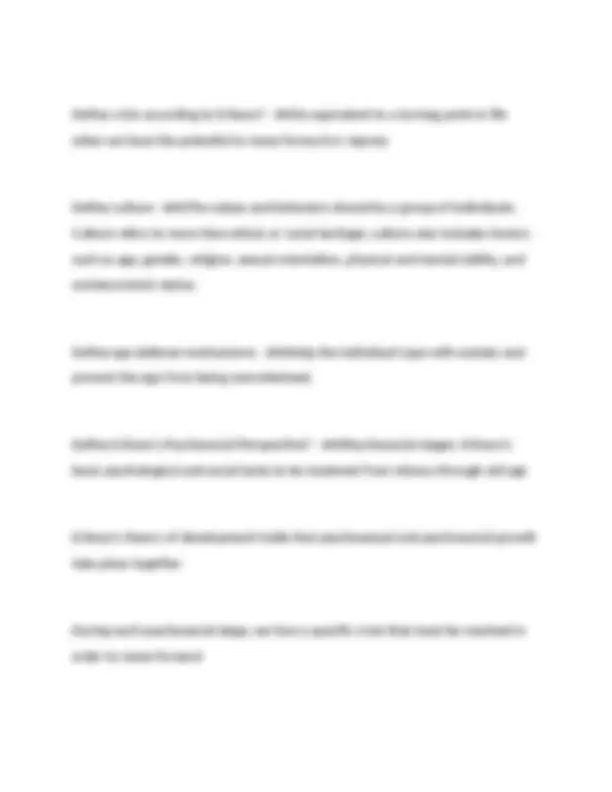
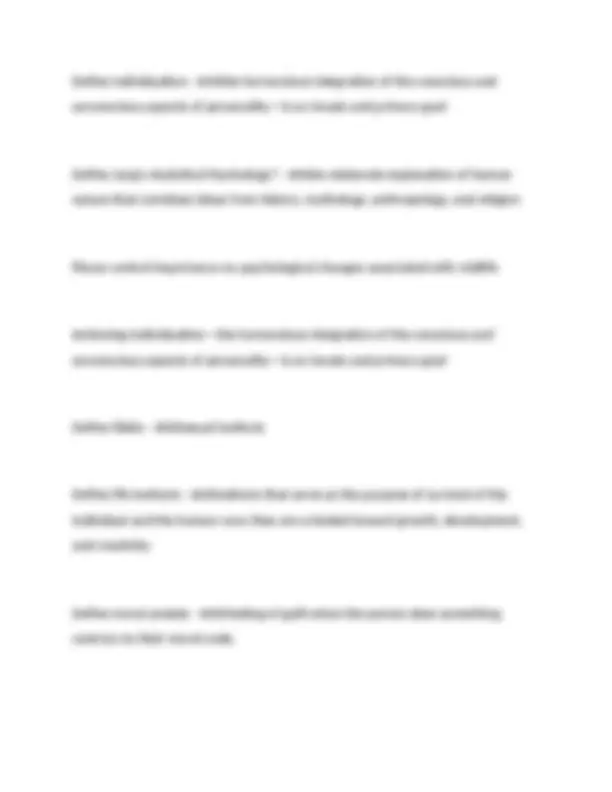
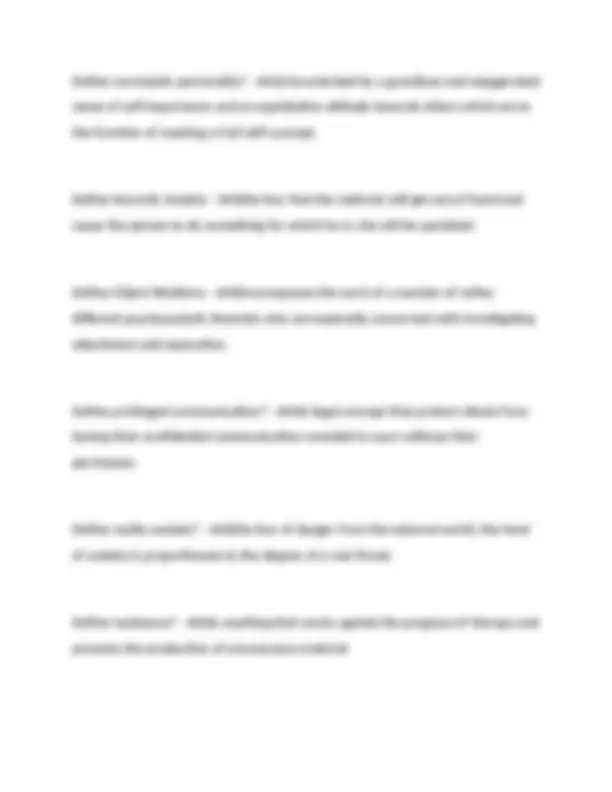
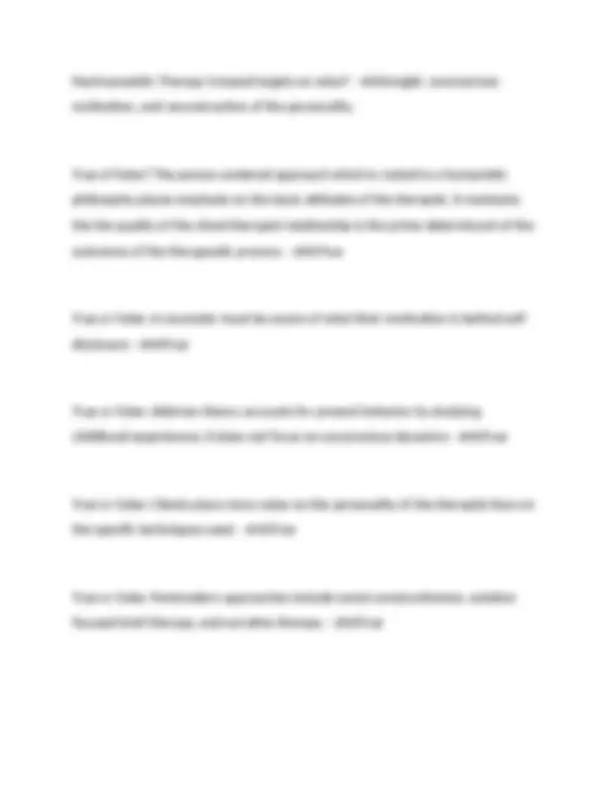
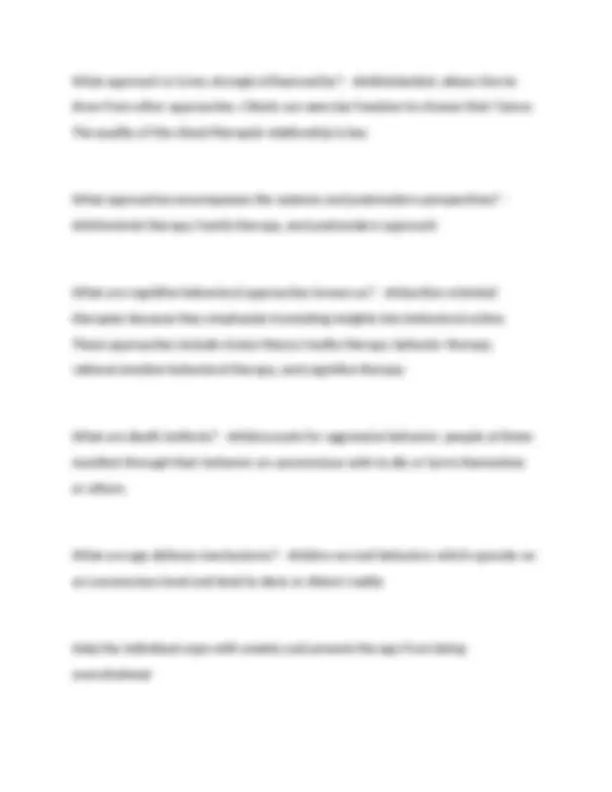
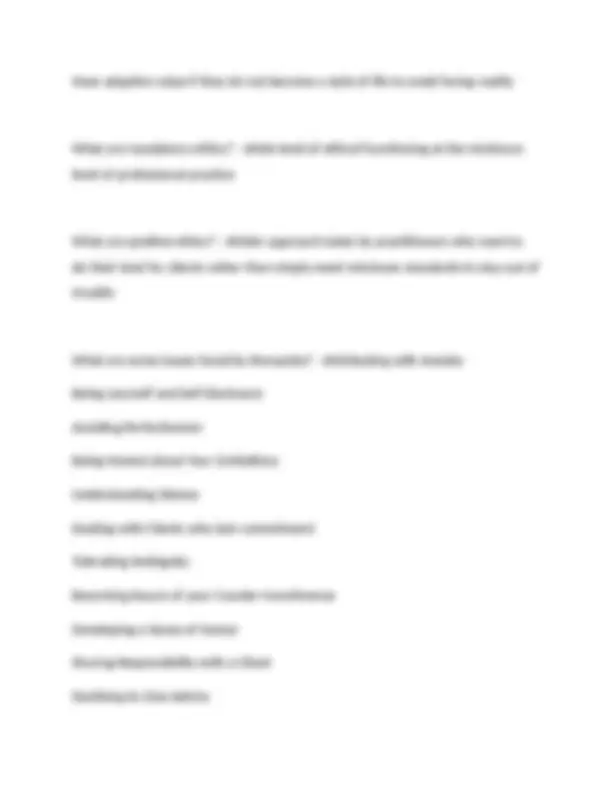
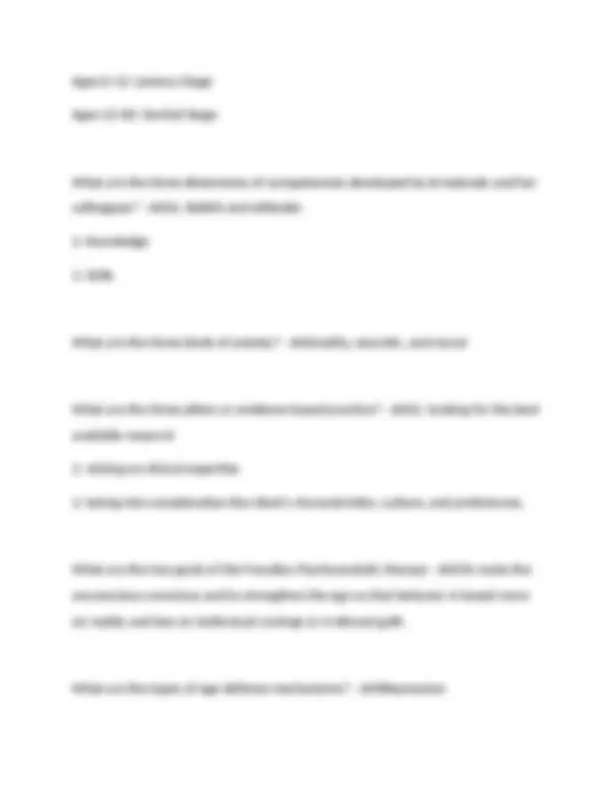
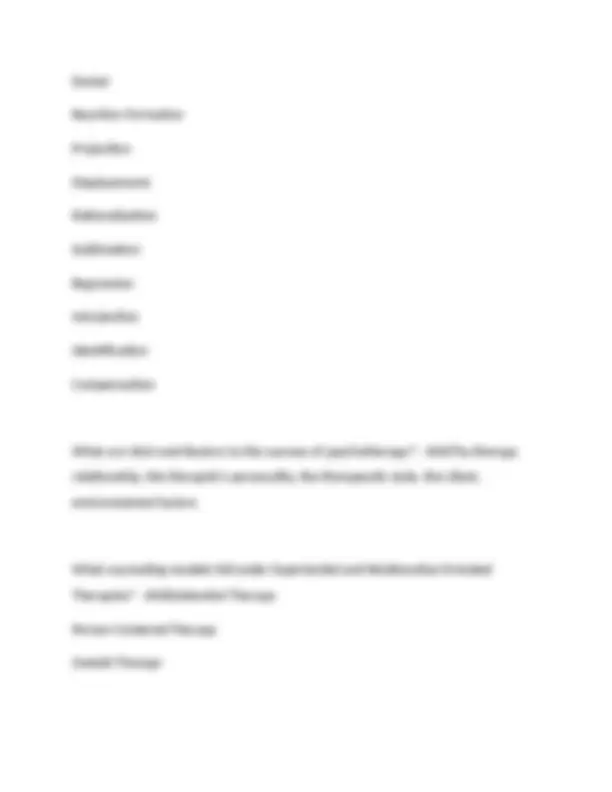
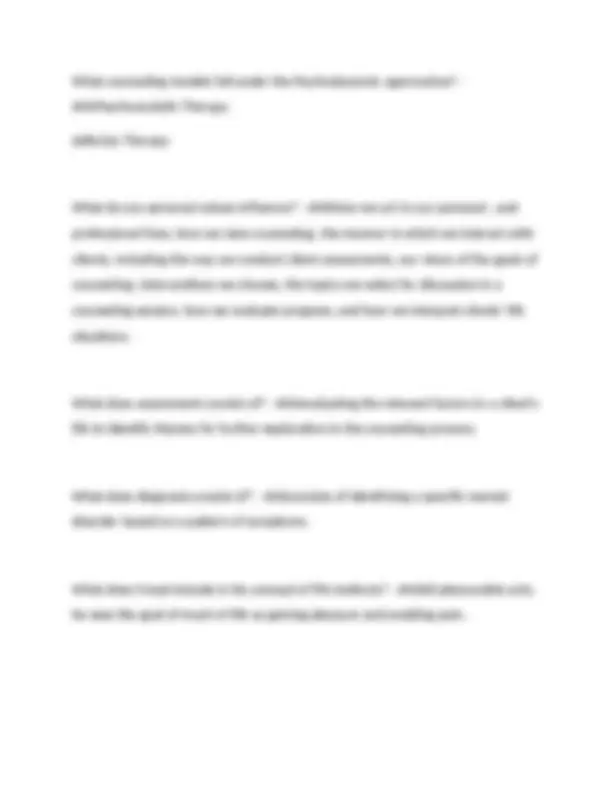
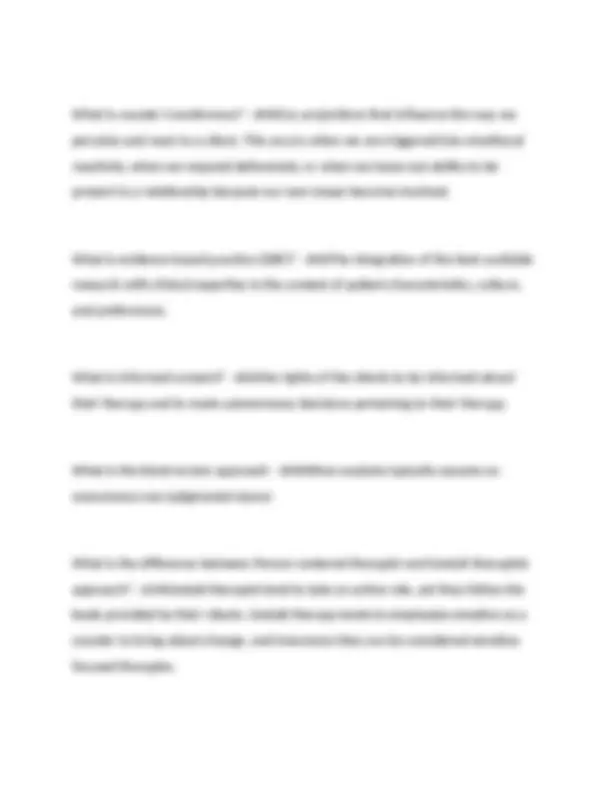
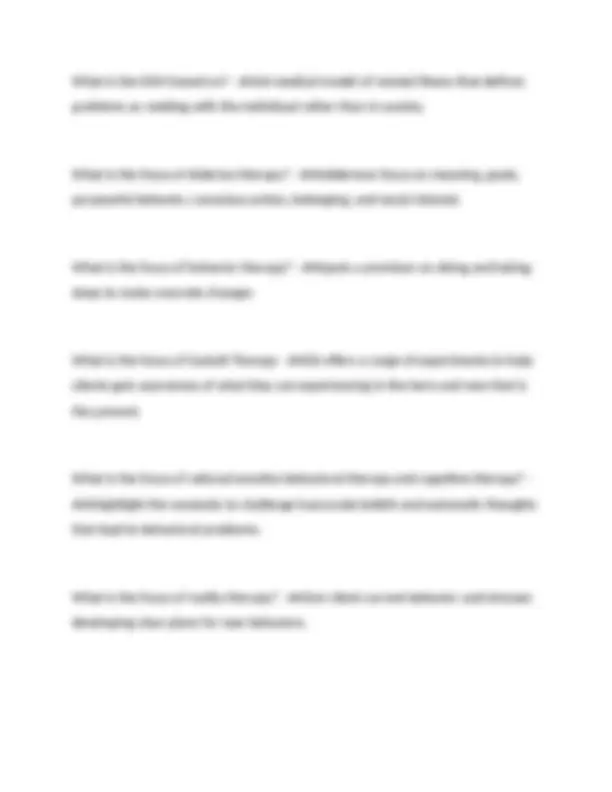
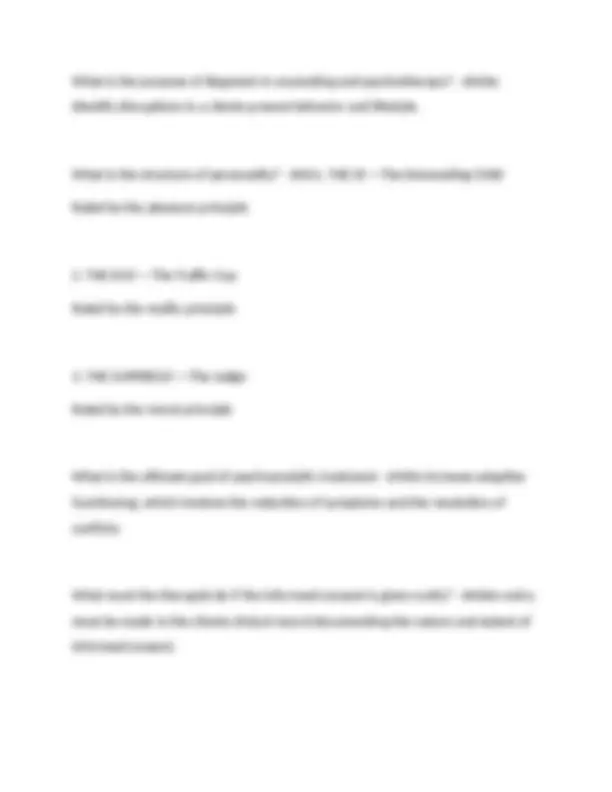
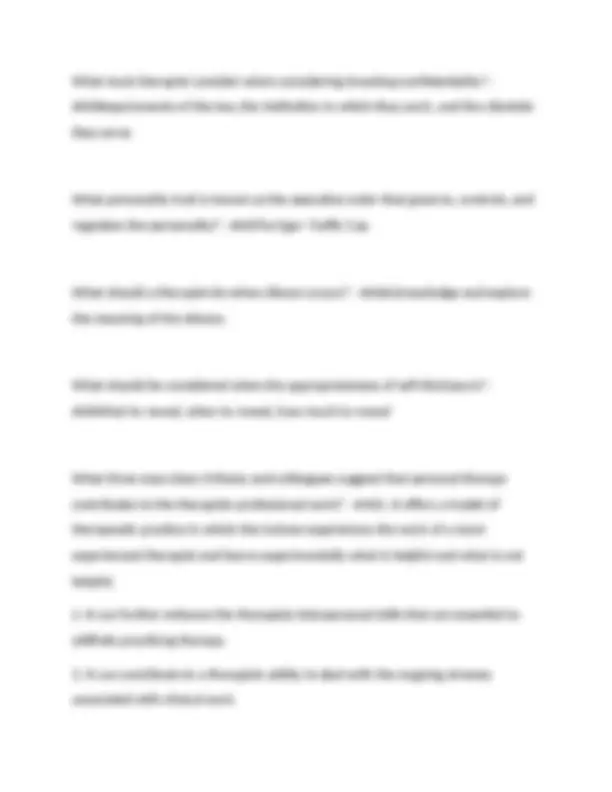
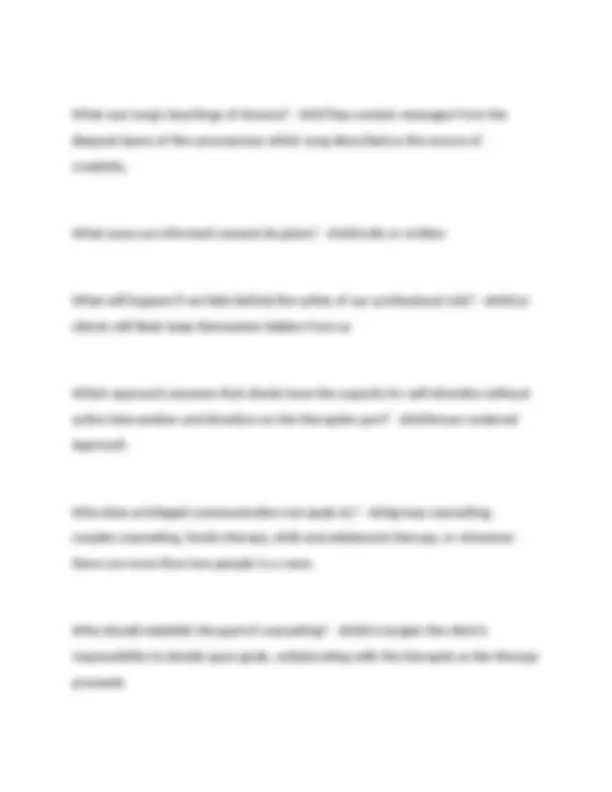
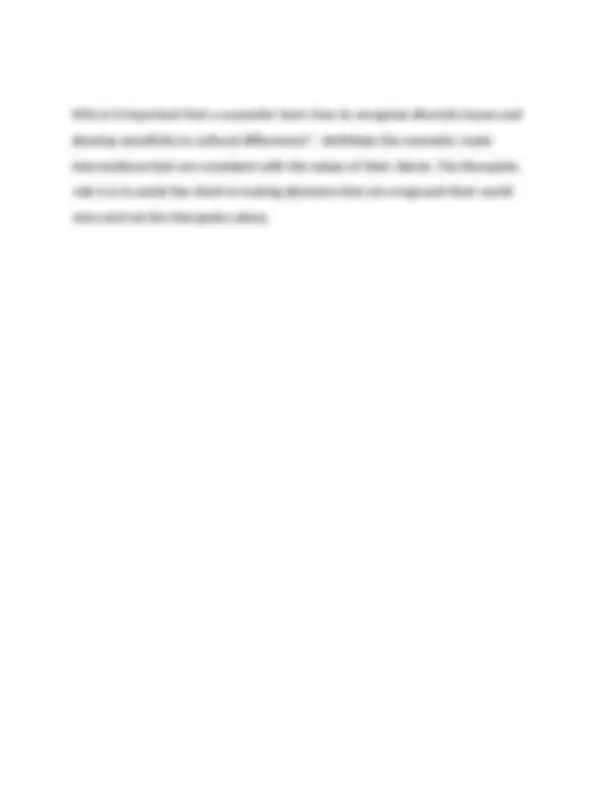


Study with the several resources on Docsity

Earn points by helping other students or get them with a premium plan


Prepare for your exams
Study with the several resources on Docsity

Earn points to download
Earn points by helping other students or get them with a premium plan
Community
Ask the community for help and clear up your study doubts
Discover the best universities in your country according to Docsity users
Free resources
Download our free guides on studying techniques, anxiety management strategies, and thesis advice from Docsity tutors
A comprehensive set of questions and answers related to the theory and practice of counseling and psychotherapy. It covers key concepts from various theoretical perspectives, including psychodynamic, humanistic, and cognitive-behavioral approaches. Valuable for students studying counseling and psychotherapy, as it offers insights into important concepts and their applications in practice.
Typology: Exams
1 / 23

This page cannot be seen from the preview
Don't miss anything!
















According to Corey, what is the counseling task? - ANSTo assist individuals in finding answers that are most congruent with their own values. According to Corey, what is the counselors role? - ANSTo create a climate in which clients can examine their thoughts, feelings, and actions and to empower them to arrive at their own solution to the problems they face. According to Freud, how is our behavior determined? - ANSIrrational forces, unconscious motivations, and biological and instinctual drives as these evolve through psychosexual stages in the first 6 years of life. According to Freud, what three systems does the personality consist of? - ANSid, ego, superego Define anxiety? - ANSA feeling of dread that results from repressed feelings, memories, desires, and experiences that emerge to the surface of awareness.
Define boundary crossing - ANSdeparture from a commonly accepted practice that could potentially benefit the client. Define boundary violation - ANSA serious breach that harms the client and therefore unethical. Define Bracketing - ANSManaging ones personal values so that they do not contaminate the counseling process Define brief psychodynamic therapy - ANSApplies the principles of psychodynamic theory and therapy to treating selective disorders within 10 to 25 sessions Define collective unconscious? - ANSThe deepest and least accessible level of the psyche. Define confidentiality? - ANSAn ethical concept and in most states is the legal duty to not disclose information about a client. However client confidentiality is not guaranteed is subpoenaed. Define Countertransference? - ANSis the reaction of the therapist toward the client that may interfere with objectivity
Define individuation - ANSthe harmonious integration of the conscious and unconscious aspects of personality—is an innate and primary goal Define Jung's Analytical Psychology? - ANSAn elaborate explanation of human nature that combines ideas from history, mythology, anthropology, and religion Places central importance on psychological changes associated with midlife Achieving individuation—the harmonious integration of the conscious and unconscious aspects of personality—is an innate and primary goal Define libido - ANSSexual instincts Define life instincts - ANSInstincts that serve as the purpose of survival of the individual and the human race; they are oriented toward growth, development, and creativity. Define moral anxiety - ANSFeeling of guilt when the person does something contrary to their moral code.
Define narcissistic personality? - ANScharacterized by a grandiose and exaggerated sense of self-importance and an exploitative attitude towards others which serve the function of masking a frail self-concept. Define Neurotic Anxiety - ANSthe fear that the instincts will get out of hand and cause the person to do something for which he or she will be punished. Define Object Relations - ANSEncompasses the work of a number of rather different psychoanalytic theorists who are especially concerned with investigating attachment and seperation Define privileged communication? - ANSA legal concept that protect clients from having their confidential communication revealed in court without their permission. Define reality anxiety? - ANSthe fear of danger from the external world, the level of anxiety is proportionate to the degree of a real threat. Define resistance? - ANSis anything that works against the progress of therapy and prevents the production of unconscious material
Define the relational Psychoanalysis? - ANSEmphasizes the interactive process between client and therapist Define the unconscious? - ANSstores all experiences, memories, and repressed materials Define the working-through process? - ANSconsists of repetitive and elaborate explorations of the unconscious material and defenses, most of which originated in early childhood. Define Transference - ANSoccurs when the client reacts to the therapist as he or she did to an earlier significant other Define value imposition - ANSwhen a counselor directly attempts to define a clients values, attitudes, beliefs, and behaviors. How can a therapist handle a demanding client? - ANSMake your expectations and boundaries clear during the initial counseling sessions or in the disclosure statement.
Psychoanalytic Therapy is based largely on what? - ANSInsight, unconscious motivation, and reconstruction of the personality. True of False? The person-centered approach which is rooted in a humanistic philosophy places emphasis on the basic attitudes of the therapist. It maintains the the quality of the client-therapist relationship is the prime determinant of the outcomes of the therapeutic process. - ANSTrue True or False: A counselor must be aware of what their motivation is behind self- disclosure - ANSTrue True or False: Alderian theory accounts for present behavior by studying childhood experiences; it does not focus on unconscious dynamics - ANSTrue True or False: Clients place more value on the personality of the therapist than on the specific techniques used. - ANSTrue True or False: Postmodern approaches include social constructionism, solution focused brief therapy, and narrative therapy. - ANSTrue
Have adaptive value if they do not become a style of life to avoid facing reality What are mandatory ethics? - ANSA level of ethical functioning at the minimum level of professional practice What are positive ethics? - ANSAn approach taken by practitioners who want to do their best for clients rather than simply meet minimum standards to stay out of trouble What are some issues faced by therapists? - ANSDealing with Anxiety Being yourself and Self-Disclosure Avoiding Perfectionism Being Honest about Your Limitations Understanding Silence Dealing with Clients who lack commitment Tolerating Ambiguity Becoming Aware of your Counter-transference Developing a Sense of Humor Sharing Responsibility with a Client Declining to Give Advice
Defining your Role as a Counselor Learning to Use Techniques Appropriately Developing your own Counseling Style Maintaining Your Vitality as a Person ans as a Professional What are some psychoanalytic techniques used by a therapist? - ANSMaintaining the Analytic Framework Therapist uses a range of procedural and stylistic factors (e.g., analyst's relative anonymity, consistency of meetings) Analysis of resistance Therapist helps clients become aware of reasons for their resistance so they can deal with them Analysis of transference Therapist uses this to elucidate client's intrapsychic life Free Association Client reports immediately without censoring any feelings or thoughts
Ages 6-12: Latency Stage Ages 12-60: Genital Stage What are the three dimensions of competencies developed by Arredondo and her colleagues? - ANS1. Beliefs and attitudes
Denial Reaction Formation Projection Displacement Rationalization Sublimation Regression Introjection Identification Compensation What are vital contributors to the success of psychotherapy? - ANSThe therapy relationship, the therapist's personality, the therapeutic style, the client, environmental factors What counseling models fall under Experiential and Relationship-Oriented Therapies? - ANSExistential Therapy Person-Centered Therapy Gestalt Therapy
What does the DSM not account for? - ANSthe political, economic, social, and cultural factors in the lives of clients, which may play a significant role in the problems of clients. What does the existential approach stress? - ANSA concern for what it really means to be human. It suggests that certain themes that are apart of the human condition, such as freedom and responsibility, anxiety, guilt, awareness of being finite, creating meaning in the world, and shaping ones future by making active choices. This approach is a philosophy of counseling that stresses the divergent methods of understanding the subjective world of the person. What does the systems orientation stress? - ANSThe importance of understanding individuals in the context of the surroundings that influence their development. To bring out individual change it is essential to pay attention to how the individuals personality has been affected by his or her gender-role socialization, culture, family, and other systems. What ethical dilemma is created when diagnosis is done? - ANSIf it is done strictly for insurance purposes, which often entails arbitrarily assigning a client to a diagnostic classification What happens if a therapist resolves a clients struggles for them? - ANSWe will foster their dependence on us
What information can a diagnosis include? - ANSexplanation of the causes of the clients difficulties account of how the problems developed over time classification of an disorders specification of preferred treatment procedure estimate for the chance of successful resolution What is a danger of the diagnostic approach? - ANSthe possible failure of counselors to consider ethnic and cultural factors in certain patterns of behavior. What is aspirational ethics? - ANSThe focus on doing what is in the best interest of the client. What is central to the Freudian approach? - ANSInstincts What is considered the judicial branch of personality? - ANSThe superego What is Corey's perspective on the eleven therapeutic approaches presented in the book? - ANSNo single model can explain all the facets of human experience.
What is the DSM based on? - ANSA medical model of mental illness that defines problems as residing with the individual rather than in society. What is the focus of Alderian therapy? - ANSAlderians focus on meaning, goals, purposeful behavior, conscious action, belonging, and social interest. What is the focus of behavior therapy? - ANSputs a premium on doing and taking steps to make concrete changes What is the focus of Gestalt Therapy - ANSIt offers a range of experiments to help clients gain awareness of what they are experiencing in the here and now that is the present. What is the focus of rational emotive behavioral therapy and cognitive therapy? - ANShighlight the necessity to challenge inaccurate beliefs and automatic thoughts that lead to behavioral problems. What is the focus of reality therapy? - ANSon client current behavior and stresses developing clear plans for new behaviors.
What is the purpose of diagnosis in counseling and psychotherapy? - ANSto identify disruptions in a clients present behavior and lifestyle. What is the structure of personality? - ANS1. THE ID —The Demanding Child Ruled by the pleasure principle